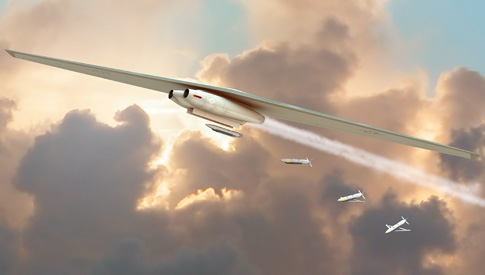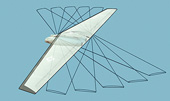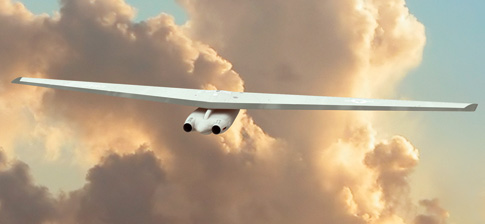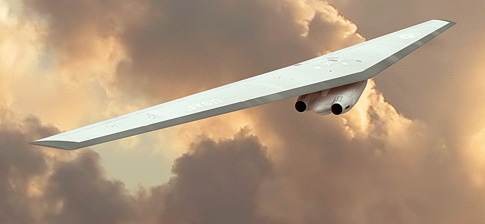Untitled Document

The unmanned Switchblade may use Small Diameter Bombs, whose wings unfold upon deployment to increase their range.
With a shift of its wing, the Pentagon’s next attack drone goes
from long-range endurance flyer to Mach-speed assassin
 |
|
As the plane approaches the sound barrier, its wing pivots into an oblique configuration to maximize aerodynamic efficiency at supersonic speeds. (John MacNeill)
|
For years, the U.S. military has wanted a plane that could loiter just outside
enemy territory for more than a dozen hours and, on command, hurtle toward a
target faster than the speed of sound. And then level it. But aircraft that
excel at subsonic flight are inefficient at Mach speeds, and vice versa. The
answer is Switchblade, an unmanned, shape-changing plane concept under development
by Northrop Grumman.
When completed (target date: 2020), it will cruise with its 200-foot-long wing
perpendicular to its engines like a normal airplane. But just before the craft
breaks the sound barrier, its single wing will swivel around 60 degrees (hence
the name) so that one end points forward and the other back. This oblique configuration
redistributes the shock waves that pile up in front of a plane at Mach speeds
and cause drag. When the Switchblade returns to subsonic speeds, the wing will
rotate back to perpendicular.
Smart plan. Now for the hard part: designing the thing. Darpa, the
Pentagon’s way-out research arm, has coughed up $10.3 million to Northrop
Grumman to produce a detailed blueprint by November 2007. A flying
test vehicle is due about four years later. The initial concept calls for a
single wing with engines situated in a pod underneath, along with munitions
and surveillance equipment. This setup will enable the wing to pivot while the
engines remain pointed in the direction the craft is traveling.

With its long, thin wing in a standard configuration, the Switchblade can maintain subsonic-speeds for at least 15 hours as it waits for a mission
This is not the first attempt at an oblique-wing aircraft. SpaceShipOne creator
Burt Rutan designed a switch-wing plane with NASA in 1979. But the slanted wings
made the craft hard to fly—when the pilot pulled the nose up, the plane
would roll to one side.
The Switchblade, however, is a good candidate to be an unmanned aerial vehicle
(UAV). The artificial intelligence used to control UAVs can handle the tricky
flight dynamics, and a computer pilot doesn’t need to eat, rest, or go
to the bathroom—useful for those 15-plus-hour missions.
If all goes well, Darpa says, a 40-foot-wingspan demonstration model could
be ready by 2010, and a full-size Switchblade should be all set for a brawl
by 2020.

With its wing cocked forward, the Switchblade flies at Mach 2 toward a target up to 2,500 nautical miles away.
Switchblade
Objective: To function efficiently as both an endurance
aircraft and as a supersonic airplane by changing its shape midflight
Time Frame:Design by 2007; one-fifth-scale technology
demonstration vehicle by 2010; ready for service as early as 2020
Wingspan: 200 feet
Range: 5,000 nautical miles
Max. Altitude: 60,000 feet
Max. Speed: Mach 2
_____________________
Read from Looking Glass News
Special
forces to use strap-on "Batwings"
Meet
Our New Stormtroopers
Military
creating 'Rods from God"
Drone
aircraft may prowl U.S. skies
US
to test 700-tonne explosive
U.S.
military plans to make insect cyborgs
Pentagon
Develops Brain Implants to Turn Sharks into Military Spies
DRONES
"TO FLY OVER CITIES"
The
Suicide Machine
Attack
of the drones
Beam
weapons almost ready for battle
HELLADS:
Lightweight Laser Cannon
"Eyes
in the sky" for homeland security

